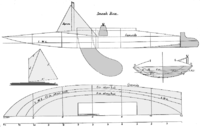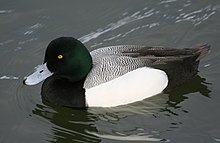Sneakbox
It was conceived as a low-profile, lightweight, seaworthy hunting craft that one person could easily handle in any of the weather conditions likely to be encountered in the Jersey marshes.
Sneak boat hunting is a sub-specialty of traditional waterfowl hunting used for diver ducks which is done in a low profile canoe looking boat that is some times motorized and made of a unique designs to allow hunter to maintain a close position to the water in order to conceal them in open water and allow them to drift into rafts of ducks using the wind.
Most laws allow sneak boats to be paddled to increase the speed need to reach open water rafts of ducks.
The main focus of the sneak boat is to put the hunter very close to the decoys or rafts of live waterfowl if not directly into them for additional closer shooting.
Open water sneak boat hunters are well known to be a hearty bunch and are known for operating on the riskier side of waterfowl hunting.
They usually accompany two hunters at a time using the wind to catch a sail like blind in the front of the boat while also sculling to achieve greater speed.
Sneak boat hunters sometimes uses small spreads of decoys in open water while they lay and wait some distance away watching with binoculars.
Nevertheless, Four Months is one of the first small-boat camp-cruising narratives published in America, where the author was not an explorer or adventurer, but simply a sportsman or boating enthusiast.
It was important that the boat should be sufficiently light to enable a single sportsman to pull her from the water on to the low points of the bay shores.
During the winter months, when the great marshes were at times incrusted with snow, and the shallow creeks covered with ice,--obstacles which must be crossed to reach the open waters of the sound,--it would be necessary to use her as a sled, to effect which end a pair of light oaken strips were screwed to the bottom of the sneak-box, when she could be easily pushed by the gunner, and the transportation of the oars, sail, blankets, guns, ammunition, and provisions (all of which stowed under the hatch and locked up as snugly as if in a strong chest) became a very simple matter.
While secreted in his boat, on the watch for fowl, with his craft hidden by a covering of grass or sedge, the gunner could approach within shooting-distance of a flock of unsuspicious ducks; and this being done in a sneaking manner (though Mr.
Since Captain Seaman built his "Devil's Coffin," forty years ago, the model has been improved by various builders, until it is believed that it has almost attained perfection.
This lack of sheer is supplied by a light canvas apron which is tacked to the deck, and presents, when stretched upward by a stick two feet long, a convex surface to a head sea.
The water which breaks upon the deck, forward of the cockpit, is turned off at the sides of the boat in almost the same manner as a snow-plough clears a railroad track of snow.
The last two men have finished their voyage of life, but "Uncle Haze,"--as he is familiarly called by his many admirers,--the originator of the tiny craft which may well be called multum in parvo, and which carried me, its single occupant, safely and comfortably twenty-six hundred miles, from Pittsburgh to Cedar Keys, still lives at West Creek, builds yachts as well as he does sneak-boxes, and puts to the blush younger gunners by the energy displayed and success attained in the vigorous pursuit of wildfowl shooting in the bays which fringe the coast of Ocean County, New Jersey.
The peculiar advantages of the sneak-box were known to but few of the hunting and shooting fraternity, and, with the exception of an occasional visitor, were used only by the oystermen, fishermen, and wild-fowl shooters of Barnegat and Little Egg Harbor bays, until the New Jersey Southern Railroad and its connecting branches penetrated to the eastern shores of New Jersey, when educated amateur sportsmen from the cities quickly recognized in the little gunning-punt all they had long desired to combine in one small boat.
Mr. Charles Hallock, in his paper the "Forest and Stream," of April 23, 1874, gave drawings and a description of the sneak-box, and fairly presented its claims to public favor.
The favorite material for boat-building in the United States is white cedar (Cupressus thyoides), which grows in dense forests in the swamps along the coast of New Jersey, as well as in other parts of North America.
Waters of Troy, and the seamless wooden canoes of Messrs. Herald, Gordon & Stephenson, of the province of Ontario, Canada, in freedom from leakage.
One bright morning, in the early part of the fall of 1875, I trudged on foot down one of the level roads which lead from the village of Manahawken through the swamps to the edge of the extensive salt marshes that fringe the shores of the bay.
When about half-way from its end, I turned off to the right, and followed a wooded lane to the house of an honest surf-man, Captain George Bogart, who had recently left his old home on the beach, beside the restless waves of the Atlantic, and had resumed his avocation as a sneak-box builder.
As time passed, the yachting fraternity based a racing boat on the working sneakbox by scaling it up, making it longer and beamier.

